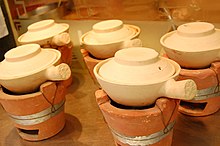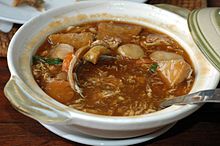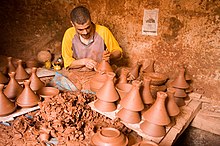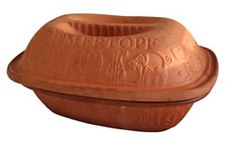
An omelette is a dish made from eggs, fried with butter or oil in a frying pan. It is a common practice for an omelette to be folded around fillings such as chives, vegetables, mushrooms, meat, cheese, onions or some combination of the above. Whole eggs or egg whites are often beaten with a small amount of milk, cream, or water.
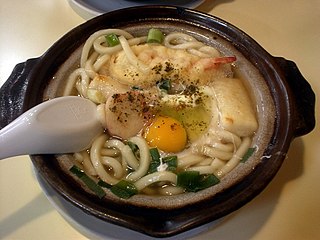
Donabe are pots made out of a special clay for use over an open flame in Japanese cuisine, and in the case of semi-stoneware Banko ware of high petalite content. Often, the food is cooked at the table on a gas burner for various nabemono dishes such as shabu-shabu and dishes served simmering including nabeyaki udon. They are sized by sun, one of the Japanese units of measurement.
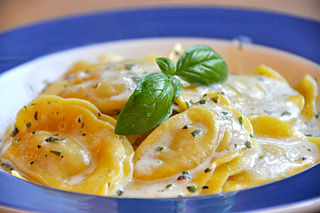
Ravioli are a type of stuffed pasta comprising a filling enveloped in thin pasta dough. Usually served in broth or with a sauce, they originated as a traditional food in Italian cuisine. Ravioli are commonly square, though other forms are also used, including circular and semi-circular (mezzelune).

A tajine or tagine is a North African dish, named after the earthenware pot in which it is cooked. It is also called maraq or marqa.

Daube is a French slow-cooked stew, usually of beef, but other meat is sometimes used. The best-known is the bœuf en daube à la provençale, a provençal stew made with cheaper cuts of beef braised in wine, with vegetables, garlic and herbs, and traditionally cooked in a daubière – a braising pot.

Tavče gravče is a traditional Macedonian dish. It is prepared with fresh beans and can be found in many restaurants in North Macedonia. It is also commonly eaten by the Macedonian diaspora. This meal is baked and served in a traditional unglazed earthenware pot. The name of the dish may be translated as "beans on a tava". Tavče gravče is considered the national dish of North Macedonia. "Tavče gravče Tetovo style" is a popular regional variation.
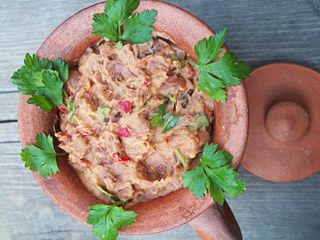
Lobio is a traditional Georgian dish of various kinds of prepared beans, containing coriander, walnuts, garlic and onion. There are many varieties of lobio, both hot and cold.
Teleme or teleme peyniri is a white semi-soft cheese made from cow’s, goat's, and sheep's milk originating in ancient times in the Middle East and Mediterranean.
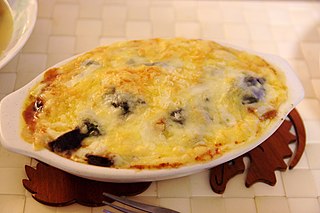
A tian is an earthenware vessel of Provence used both for cooking and serving. It is also the name of the dish prepared in it and baked in an oven.

Ribollita is a Tuscan bread soup, panade, porridge, or potage made with bread and vegetables, often from leftovers. There are many variations but the main ingredients always include leftover bread, cannellini beans, lacinato kale, cabbage, and inexpensive vegetables such as carrot, beans, chard, celery, potatoes, and onion. Its name means 'reboiled'. It is often baked in a clay pot.

Tripes à la mode de Caen is a traditional dish of the cuisine of Normandy, France.
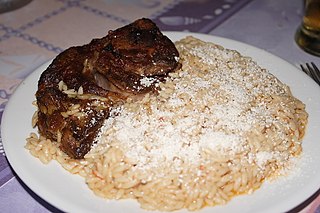
Giouvetsi, yiouvetsi, or youvetsi is a Greek dish made with chicken, lamb or beef and pasta, either kritharaki (orzo) or hilopites, and tomato sauce. Other common ingredients include onions/shallots, garlic, beef stock, and red wine. It is characteristically baked in a clay pot, a güveç, and served with grated cheese.

Beggar's chicken is a Chinese dish of chicken that is stuffed, wrapped in clay and lotus leaves, and baked slowly using low heat. Preparation of a single portion may take up to six hours. Although the dish is traditionally prepared with clay, the recipe has evolved; for convenience and safety it is often baked with dough, oven bags, ceramic cooking pots, or convection ovens.

A Greek restaurant is a restaurant that specializes in Greek cuisine. In the United States they tend to be a different affair, varying in types of service, cuisine, menu offerings, table settings, and seating arrangements. Their menu may also feature dishes from other cuisines.

Güveç is a family of earthenware pots used in Balkan, Persian, Turkish, and Levantine cuisine; various casserole or stew dishes cooked in them are called ghivetch. The pot is wide and medium-tall, can be glazed or unglazed, and the dish in it is cooked with little or no additional liquid.
Sorkun is a village in the İskilip District of Çorum Province in Turkey. Its population is 289 (2022).

Ghivetch is a traditional Balkan autumn vegetable stew most closely associated with Romania, where it is a national dish, and Bulgaria. It is traditionally cooked in an earthenware pot called a güveç. It is often made only with vegetables, though some versions include meat, fish, or poultry. The Washington Post in 1985 called it "one of the world's great vegetable melanges". Mimi Sheraton called it "really the last word in vegetable stews".
Koutoukia are informal or underground restaurants or taverna, typically run by women, in Greece. The typical koutouki has between eight and ten tables and are often run in the owner's house. Some are operated in back yards, gardens, or basements. Traditionally koutoukia served only men.


